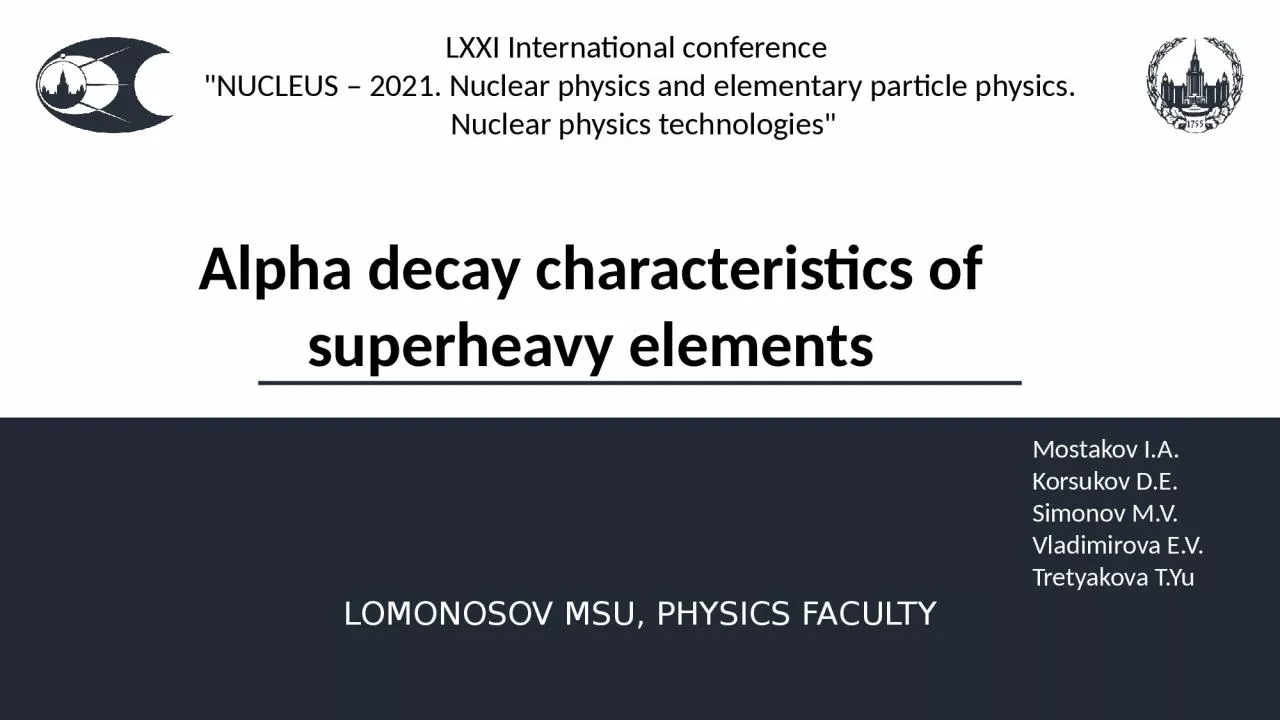

Simonov MV Vladimirova EV Tretyakova TYu Alpha decay characteristics of superheavy elements LXXI International conference NUCLEUS 202 1 Nuclear physics and elementary particle physics ID: 1034364
Download Presentation The PPT/PDF document "Mostakov I.A. Korsukov D.E." is the property of its rightful owner. Permission is granted to download and print the materials on this web site for personal, non-commercial use only, and to display it on your personal computer provided you do not modify the materials and that you retain all copyright notices contained in the materials. By downloading content from our website, you accept the terms of this agreement.
1. Mostakov I.A.Korsukov D.E. Simonov M.V.Vladimirova E.V.Tretyakova T.YuAlpha decay characteristics of superheavy elementsLXXI International conference "NUCLEUS – 2021. Nuclear physics and elementary particle physics. Nuclear physics technologies"LOMONOSOV MSU, PHYSICS FACULTY
2. Map of superheavy elements (SHE)Nucleus-2021NZα-decayfission β+-decay, e-captureMassMain decay modes :Experimental data :Energy of α-decay2 / 9 Alpha decay characteristics of superheavy elementsMostakov I.A. et al.
3. Residual np-interactionNucleus-2021Alpha decay characteristics of superheavy elementsN Evaluated binding energy B (1 of 4 possible formulas):Mass relations for estimating np-correlations: Experiment 1st step 2nd step 3rd stepZStep by step calculations3 / 9157106Energy of α-decayOld calculation areaNew calculation area Additional data: energy of α-decay: Predicted binding energy B:Mostakov I.A. et al.
4. Approximation Nucleus-2021 MeVА experimental, odd А (АМЕ2020) experimental, even А (АМЕ2020)− A evenA oddC1, MeV 0,0810,006γ–2/30RMSD, keV138110A evenA oddC1, MeV γ–2/30RMSD, keV1381104 / 9Approximation area: A 180 (heavy isotopes) The difference between the theoretical binding energies and the AME2020 dataAlpha decay characteristics of superheavy elementsMostakov I.A. et al.
5. Nucleus-2021Evaluations for 108-118 elements. Binding energyMostakov I.A. et al.5 / 9B/A, MevB/A, MevNNAlpha decay characteristics of superheavy elements
6. Nucleus-2021Evaluations for 108-118 elements. Energy of α-decayMostakov I.A. et al.6 / 9NN Alpha decay characteristics of superheavy elements
7. Nucleus-2021Evaluations for 108-118 elements. α-decay half-lifeMostakov I.A. et al.7 / 9 Alpha decay characteristics of superheavy elementsViola-Seaborg’s formula:[V. E. Viola, G. T. Seaborg et al. // Nucl. Chem. 28, 741 (1966)]Parametrization taken from: [A. Parkhomenko, A. Sobiczewski // Acta Phys. Polonica B. vol. 36 № 10 (2005)]
8. Nucleus-2021Evaluations for 108-118 elements. α-decay half-lifeMostakov I.A. et al.8 / 9 Alpha decay characteristics of superheavy elements
9. Nucleus-2021ConclusionMostakov I.A. et al.9 / 9Alpha decay characteristics of superheavy elementsUsing AME 2020 data, new approximations were obtained for np-correlations 𝛥_𝑛𝑝. Refinement and use of α decay 𝑄_α data made it possible to calculate the binding energies of B/A of the nuclei up to oganesson isotopes Z = 118.Based on the obtained binding energies B/A the α-decay energy 𝑄_α and half-life 𝑇_α are calculated for superheavy nuclei with 𝑍 = 108 –118. To assess the accuracy and reliability of the method, the results were compared with the experiment and the results of other methods. The comparison demonstrates the sufficient accuracy of this method for a large number of superheavy nuclei. But with an increase in Z and N, the accuracy begins to drop, which can be associated with the accumulation of errors from several iterations of the method.